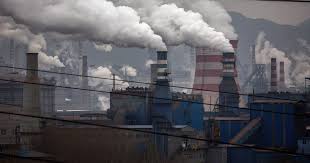Beijing/UN Headquarters — China has announced a new pledge to cut its greenhouse gas emissions by 7–10 percent from peak levels by 2035, in what experts call both a milestone and a missed opportunity for the world’s biggest carbon polluter to lead the global fight against climate change.
In a video address to the United Nations General Assembly on Wednesday, Chinese President Xi Jinping said Beijing would also boost the share of non-fossil fuel sources in its energy consumption to over 30 percent and expand wind and solar power capacity sixfold compared with 2020 levels.
“The shift away from carbon is the trend of our time,” Xi told delegates, pledging that China would play its part in building a greener future.
While many hailed China’s first-ever explicit commitment to reduce emissions outright — beyond just capping their growth — climate analysts warned that the target was far below what is needed to keep global temperature rise below 1.5°C, the goal enshrined in the 2015 Paris Agreement.
“It’s unfortunately very disappointing,” said Bill Hare, CEO of the Berlin-based Climate Analytics. “This target will not drive down emissions meaningfully — it is even below what China was already on track to achieve under current policies.”
According to the Centre for Research on Energy and Clean Air (CREA), China would need to cut emissions by about 30 percent by 2035 to be aligned with the Paris Agreement trajectory.
China’s announcement comes at a pivotal moment: the United States has effectively abandoned its own climate targets under President Donald Trump, who in his UN speech this week called climate science “the greatest con job ever perpetrated on the world.”
That shift leaves Beijing under pressure to fill the global leadership gap on climate. Analysts say that while the new pledge is incremental, it signals that China is positioning itself as a serious, though cautious, actor in the global climate arena.
“Beijing is choosing to tiptoe forward when science calls for a full sprint,” said Li Shuo, director of the China Climate Hub at the Asia Society Policy Institute. “This is a missed opportunity for China to seize the mantle of climate leadership.”
China is responsible for roughly one-third of global carbon emissions, making its climate policies crucial to the planet’s future. Yet it is also the world’s top producer of green technology, manufacturing about 80% of solar panels, 70% of electric vehicles, and 60% of wind turbines.
Xi’s pledge to dramatically expand renewables could accelerate this transformation — but critics note that China is simultaneously ramping up coal.
Last year, Beijing approved nearly 100 gigawatts of new coal-fired power projects — the highest in a decade — despite Xi’s earlier promise to “strictly control” coal development.
“China’s new pledge clearly falls short of expectations,” said Andreas Sieber of 350.org. “The targets are vague on the base year and too conservative on renewables, leaving room for emissions growth in coal-heavy sectors.”
Some analysts say the modest target reflects Beijing’s cautious approach: it prefers to set goals it can confidently surpass rather than risk public failure.
“What’s hopeful is that the actual decarbonisation of China’s economy is likely to exceed its target on paper,” said Yao Zhe, policy adviser at Greenpeace East Asia, pointing to data suggesting that China’s power-sector emissions could peak this year.
If China can accelerate its transition — especially by curbing coal — it could significantly shift the global emissions curve. With the United States sidelined, many observers believe Beijing holds the key to preventing catastrophic warming.
“China’s dominant role in clean tech gives it a unique chance to lead,” Li Shuo said. “Whether it seizes that moment will shape the planet’s climate trajectory for decades to come.”
For now, the world is watching whether China’s pledge marks the beginning of a more ambitious era — or just another incremental step too small to avert a climate crisis.



